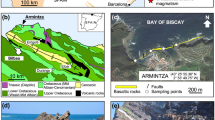Abstract
The Niutoushan basaltic cone, consisting of subalkali (quartz-tholeiite and olivine-tholeiite) and alkali basalts, is Late Tertiary in age. Its major characteristics are generalized as follows:
-
(1)
Both early subalkali and late alkali bali basalts are formed under the same geological environment.
-
(2)
The continuity in chemical composition from subalkali to alkali and the low FeO/MgO in alkali basalts show that they are the products of cognate magmatic differentiation.
-
(3)
The change from low REE abundance and weak enrichment of LREE in subalkali to high REE abundance and strong enrichment of LREE in alkali basalts indicates obvious REE enrichment and fractionation during magmatic differentiation. Weak positive Eu anomalies in the REE patterns are indicative of their formation under low oxygen fugacity conditions.
-
(4)
According to the calculated values, 70–75% of the primary olivine tholeiitic magma had been separated as subalkaline basaltic magma, the rest residual magma became alkaline basaltic magma. This result is consistent to the field observation that the outcrop area of subalkali basalts is four times as much as that of alkali basalts.
-
(5)
The basaltic rocks of Niutoushan show an S-type distribution straddling the thermal barrier on Ol′-Ne′-Qu′ diagram and an evolution tendency for Ne to increase with increasing FeO/MgO. This is in agreement with the melting experimental data on olivine basalts at 10–20 kb.
-
(6)
Mantle-derived inclusions (spinel lherzolite) in this area occur in both alkali olivine basalts and olivine tholeiites. The latter is of extremely rare occurrence. The formation temperature and pressure of the inclusions in alkalibasalts and olivine tholeiites have been calculated. The results show that the alkaline basaltic magma was separated from the subalkaline basaltic magma at about 20 kb.
Basaltic rocks in Niutoushan were formed through the so-called “high pressure differentiation”, that is, at about 20 kb the crystallization of clinopyroxene and orthpyroxene resulted in the separation of subalkaline basaltic magma from the primary olivine tholeiitic magma, and then the residue gradually became alkaline olivine basaltic magma.
Similar content being viewed by others
References
Zhao Zongpu, Acta Geological Sinica, 36(1956), 315–367.
Liu Ruoxin et al., Geochemistry, 1(1983), 17–33.
Zhou Xinghua and Richard, D. H., Earth Planet. Sci. Lett., 58(1982), 301–329.
Zhou Xinmin, Journal of Nanjing University (Natural Science), 3(1981), 382–392 (in Chinese).
Bultitude, R. J. and Green, D. H., J. Petrol., 12(1971), 121–147.
Bor-Ming Jahn et al., J. Petrol., 21(1980), 201–244.
Anthony J. Irving, Am. J. Sci., 280 A(1980),389–426.
Shaw, D. M., Geochim. et Cosmochim. Acta, 34(1970), 237–243.
Ringwood, A. E., Composition and Petrology of the Earth’s Mantle, NcGraw-Hill, New York, (1975), 124–125.
Poldervard, A., Geol. Soc. Am. Bull., 75(1964), 229–232.
Akiho Miyashiro, Contrib. Mineral. Petrol., 66(1978), 91–104.
Tilley, C. E. et al., Carnegie Inst. Washington Yearbook, 62(1963), 77–84.
Tilley, C. E. et al., Carnegie Inst. Washington Yearbook, 63 (1964), 92–97.
Tilley, C. E. et al., Carnegie Inst. Washington Yearbook, 64 (1965), 69–82.
Green, D. H. and Ringwood, A. E., Contrib. Mineral. Petrol., 15(1967a), 103–190.
Binns, R. A., Am. J. Sci., 267 A(1969), 33–49.
Bor-Ming John et al., Geol. Sco. Amer. Bull., 87(1976), 763–776.
Huang Wankang et al., Geochemistry, 2(1983), 361–376.
Frey, F. A. and Green, D. H., Geochim. et Cosmochim. Acta, 38(1974), 1023–1059.
Author information
Authors and Affiliations
Rights and permissions
About this article
Cite this article
Yu, X. The origin of basaltic rocks in Niutoushan area— high pressure differentiation. Geochemistry 4, 150–158 (1985). https://doi.org/10.1007/BF03179335
Issue Date:
DOI: https://doi.org/10.1007/BF03179335




